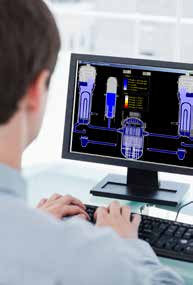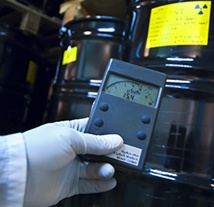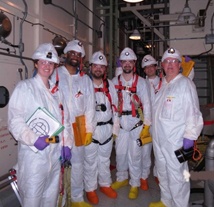By: Robert Reeves, Director, MAAP Services, Fauske & Associates, LLC (FAI)
Modular Accident Analysis Program (MAAP), which is owned by the Electric Power Research Institute (EPRI), is a computational tool that the nuclear industry has relied on for over 30 years to resolve not only severe accident issues, but also operational issues associated with nuclear power plants. Today, MAAP is primarily used within utility PRA (Probabilistic Risk Assessment) groups. Within PRA organizations, MAAP is typically used to perform thermal-hydraulic analyses in support of PRA Level I and Level II  analyses. For the Level I analyses, MAAP is used in the determination of success (i. e., is core damage avoided?) based on equipment performance. MAAP is also used to determine the time available for sensitive operator actions, which is an input to the human reliability analyses (HRA). The MAAP models of the Reactor Coolant System and complex thermal-hydraulic phenomenon are important for these analyses.
analyses. For the Level I analyses, MAAP is used in the determination of success (i. e., is core damage avoided?) based on equipment performance. MAAP is also used to determine the time available for sensitive operator actions, which is an input to the human reliability analyses (HRA). The MAAP models of the Reactor Coolant System and complex thermal-hydraulic phenomenon are important for these analyses.
For the Level II analyses, MAAP is used to assess the performance of the containment and its support systems, with the focus on accident sequences that could lead to a large breach early in the accident. The MAAP models of the Reactor Coolant System mass/energy releases, containment heat removal processes through multiple systems and heat exchangers and the containment heat-up phenomenology are all important for these analyses.
MAAP is a fast-running analytical tool suitable for predicting accident progression (i.e., core uncovery, damage, vessel breach, containment breach) and evaluating the timing and effectiveness of operator actions. MAAP represents a large number of interacting phenomena using simple, first-principle validated models (i.e., it is not restricted to just a few phenomena with very detailed models).
The MAAP5 version contains fully-integrated thermal-hydraulics (T/H) models for:
1. Primary system thermodynamics
2. Core heat-up, degradation and melting
3. Fission product release, transport, settling and heating
4. ESFs (engineered safety features)
5. Containment thermodynamics
6. Dose (in-plant and ex-plant) calculations
Many of these models have been updated since the release of MAAP4 and can provide more realistic predictions of the plant performance during a postulated accident.
A current issue within the nuclear industry is that the majority of nuclear plant PRA models are based on results from older versions of the MAAP4 computer code (i.e., MAAP4.06, MAAP4.07, etc.). There were few modeling differences associated within each minor version of MAAP4. However, over the past 10 years, EPRI has released a new version of MAAP called MAAP5 which has numerous improvements and new modeling capabilities associated with it. Significant differences are summarized below to assist in the recognition of the benefits of updating plant PRA models to use results from MAAP5.
1. MAAP4 development is no longer supported by EPRI. Thus, for any issues that arise in the future (e.g. SFP analyses, containment venting, low power shutdown analyses, etc.), MAAP4 will not have the modeling capabilities sufficient to address them. The only support EPRI currently provides associated with MAAP4 is direct utility support for user questions only.
2. The enhanced MAAP5 modeling capabilities of the PWR primary system provide a more realistic model and modeling capability to substantiate the analytical results.
- MAAP4 models the primary system as a “two-loop” system with limited controls of primary system equipment. For 3 or 4-loop designs, MAAP4 assumed that the 2 or 3 loops not associated with the accident behaved identically (so they are effectively lumped together).
- MAAP5 models each RCS loop separately and allows individual control of each loop’s equipment (i.e., RCPs, SGs feedwater control, SG safety/relief valves, ECCS injection, etc.), thus providing more accurate modeling of the EOPs and operator actions.
- MAAP4 does not possess a fully mechanistic model for natural circulation and forced circulation of the coolant’s liquid phase, whereas MAAP5 has explicit models for single-phase and twophase natural circulation and forced circulation. As a result, MAAP5 can model phase separation in the primary system. This capability is especially important in small or very small LOCA scenarios in the calculation of break flows (single versus two-phase flow), RCS pressure, and RCS water inventory. Whether or not the flow is single phase or two-phase has a noticeable impact on the timing of core uncovery and core damage. In MAAP5, phase separation is handled mechanistically by the thermal-hydraulic model without the need for extensive sensitivity studies to gain insights of the effects of the phase separation.
- Compared to MAAP4, the MAAP5 PWR RCS thermal-hydraulic model response is more similar to other commonly used industry codes such as RELAP5 and MELCOR. The MAAP5 PWR RCS thermal-hydraulic model has been validated (benchmarked) against selected experiments and approved analytical codes.
- The MAAP5 PWR RCS thermal-hydraulic model addresses a long-standing USNRC aversion to accepting some MAAP4 PWR analyses submittals due to the noted inadequacy of the MAAP4 PWR RCS model. While the MAAP5 model has not been formally reviewed by the USNRC, the MAAP5 model advancements and benchmark validations make acceptance of case-specific submittals less contentious.
- A sampling of data from a nuclear utility that is currently upgrading its PRA models to MAAP5 and is looking at the impacts of the MAAP5 upgrade on Level I success criteria, HRA timings, Level I T/H and LERF, has identified the following preliminary findings:
– Due to the improved MAAP5 modeling of the primary system and its more realistic models, MAAP5 typically shows that for small LOCAs and station blackout accidents (with seal LOCAs), there is increased time to core uncovery and core damage and/or more time to implement actions to preclude such events.
– Higher containment gas temperatures and more detailed primary system nodalization and modeling capabilities yields lower primary system heat sink temperatures, resulting in less long term cesium iodine (CsI) re-vaporization in the primary system, thus potentially lower Level II source term releases.
– Other MAAP5 enhancements to the core melt progression modeling can impact long term fission product releases as well.
- Some non-PRA features provide additional value to the end user. In particular, the full integration of the original DOSE code into the MAAP5 code framework allows for a much easier companion dose assessment to be performed in conjunction with the fission product transport and release assessment. Previously, the MAAP4 code and the DOSE code were separate autonomous codes that required the user to assemble MAAP4 output to serve as input to the DOSE code. Another added value to the user is the ability to integrate MAAP5 into the plant simulator to provide a severe accident component to operator training on severe accident management guidelines (SAMG). MAAP5 integration into a plant simulator is not an “automatic” capability that accompanies MAAP5 by default. Additional work is required to perform the integration into the simulator. However, it is noteworthy that this integration is a much easier process with MAAP5 since MAAP5 has been designed to accommodate such integration.
3. MAAP5 includes several model upgrades to assess the effects of severe accidents, including those affecting the spent fuel pool:
- The MAAP5 code provides the modeling capability to perform “Level II” type accident analysis associated with the spent fuel pool regions of the auxiliary building. It can calculate the time-to-boil and the time to uncover the fuel assemblies, and it can be used to model heatup of the fuel assemblies, Zr-water and Zr-air oxidation, fission product releases associated with the melt progression of fuel assemblies, as well as the environmental conditions within the spent fuel handling building. The MAAP5 code provides the modeling capability to perform “Level II” type accident analysis associated with the spent fuel pool regions of the auxiliary building. It can calculate the time-to-boil and the time to uncover the fuel assemblies, and it can be used to model heatup of the fuel assemblies, Zr-water and Zr-air oxidation, fission product releases associated with the melt progression of fuel assemblies, as well as the environmental conditions within the spent fuel handling building.
- MAAP5 also has the capability to model the plant in operational configurations beyond normal operations such as during low power operations (i.e., RPV head off, nozzle dam installations, pressurizer man-way open, SG manways open, etc.)
- One of the remaining severe accident challenges to containment integrity relates to the ability to cool core debris (post vessel failure) by the presence of an overlying water pool. MAAP4 predicts that if the core debris is covered by water it is either coolable or not coolable depending on the value of user-input critical heat flux parameter FCHF. Based on recent experimental data and modeling advances, MAAP5 instead has mechanistic models (bulk cooling, water ingression, and melt eruption model) to better address debris coolability. MAAP5 has been benchmarked against the latest ongoing debris coolability experiments. In addition to debris coolability, the related phenomenon of molten core-concrete interaction (MCCI) at the concrete surface has been advanced in the areas of: (i) benchmarking against state-of-the-art experiments and (ii) modeling flexibility to handle diverse circumstances.
4. In terms of licensing, the majority of the US utilities have already purchased MAAP5 licenses; therefore, the only new cost associated with updating to MAAP5 is the upgrade of the existing MAAP parameter file to MAAP5. Depending on the scope and quality of the existing MAAP4 parameter file and its supporting documentation, the cost associated with such an upgrade is generally around $50K (not including add-ons such as dose, SFP model, neutronics, detailed design-basis containment model, or other improvements that are not directly applicable to most PRAs).
5. Additionally, almost all European and Asian MAAP users are already using MAAP5, and thus, they are indirectly in control of further MAAP5 development (in terms of prioritizing what improvements and model enhancements get funded by EPRI).
In summary, MAAP5 has more realistic models, both in terms of nodalization and phenomenological models, of the Reactor Coolant System, containment, support systems and spent fuel pool. These more realistic models generally all use relaxed equipment performance requirements and relaxed operator response times. However, there are differences in each plant’s thermal-hydraulic model and PRA model, making the exact benefit for a specific plant impossible to quantify a priori.
One final consideration is that if the PRA models success criteria and operator response times are based on MAAP4 or older versions, it is likely that these analyses are at least 10 years old, and there may have been changes to the plant design and operator response capabilities that are not reflected in those thermal-hydraulic analyses. An update, or, at the least, some selective benchmarking, is likely necessary to maintain consistency with current standards for the scope and quality of the PRA models.
For more information and discussion, contact Robert Reeves, reeves@fauske.com or (630) 887-5220. www.fauske.com











